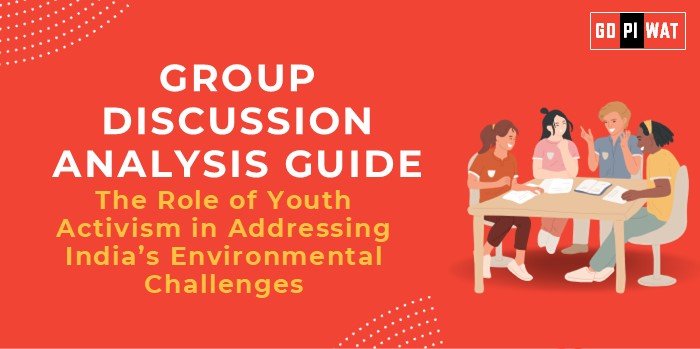📋 Group Discussion Analysis Guide: The Role of Youth Activism in Addressing India’s Environmental Challenges
💡 Introduction to the Topic
- 📖 Opening Context: “Youth activism is emerging as a transformative force in tackling India’s pressing environmental issues, from climate change to deforestation, empowering the next generation to shape a sustainable future.”
- 📜 Topic Background: Youth-led movements like Fridays for Future India and regional initiatives have gained momentum in recent years, driven by a mix of local environmental degradation and global climate urgencies. These movements aim to challenge policy inertia and promote sustainable practices.
📊 Quick Facts and Key Statistics
- 👩🎓 Youth Demographics: Over 40% of India’s population is under 25 years old – a massive potential force for activism.
- 📢 Climate Action Movements: Fridays for Future India organized 1,000+ protests since 2019, addressing climate policies.
- ♻️ Plastic Ban Compliance: Youth organizations drove compliance with India’s 2022 ban on single-use plastics in several states.
- 🌍 UN Studies: Over 60% of youth globally view climate change as their top concern, with similar sentiments reflected in India.
🌟 Stakeholders and Their Roles
- 🏛️ Government: Establishes environmental policies, allocates funds for green initiatives.
- 🧑🎓 Youth Activists: Mobilize communities, raise awareness, and advocate policy changes.
- 🌿 NGOs: Support campaigns with resources, training, and platforms for youth leaders.
- 🏢 Corporate Sector: Responds to pressure by adopting sustainable practices due to consumer activism.
- 📰 Media: Amplifies voices of young environmentalists, shaping public opinion.
📈 Achievements and Challenges
🏆 Achievements
- ✅ Policy Impact: Youth activists influenced India’s updated climate commitments (2022).
- ✅ Awareness Drives: Increased adoption of sustainable practices in urban areas (e.g., car-free days in Delhi).
- ✅ Regional Success: Activism in Kerala halted a controversial hydroelectric project.
- ✅ Innovations: Youth-led startups in waste management and renewable energy have flourished.
⚠️ Challenges
- 🚧 Policy Resistance: Bureaucratic delays and lack of enforcement.
- 🚧 Resource Constraints: Limited access to funding and platforms for marginalized youth.
- 🚧 Social Backlash: Activists often face societal and institutional pushback.
🌍 Global Comparisons
- 🇸🇪 Sweden: Greta Thunberg’s movement spurred global youth climate strikes.
- 🇮🇩 Indonesia: Youth movements halted illegal deforestation in Sumatra.
📜 Case Study
🌱 Fridays for Future India: Successfully took legal action against a mining project in Goa.
🗣️ Structured Arguments for Discussion
- 👍 Supporting Stance: “Youth activism is vital in bridging policy gaps, bringing fresh perspectives, and ensuring accountability in environmental governance.”
- 👎 Opposing Stance: “Activism often lacks measurable impact, and without structural reforms, it risks remaining symbolic.”
- ⚖️ Balanced Perspective: “While youth activism has led to awareness and policy nudges, its true potential lies in integration with governance and larger economic frameworks.”
💬 Effective Discussion Approaches
- 📈 Opening Approaches:
- Use a compelling statistic: “Over 60% of India’s youth identify climate change as their top priority…”
- Present a contrast: “While youth are protesting, India’s deforestation rates are still rising…”
- ⚡ Counter-Argument Handling:
- Example: “While symbolic actions may seem ineffective, they are instrumental in shaping public discourse and policy change.”
📋 Strategic Analysis of Strengths and Weaknesses
SWOT Analysis
- 💪 Strengths: Large youth population, technological savvy, global connections.
- ⚡ Weaknesses: Lack of resources, insufficient government recognition.
- 🌟 Opportunities: Green jobs, leadership in climate diplomacy, collaboration with international bodies.
- ⚠️ Threats: Political backlash, environmental misinformation.
📚 Connecting with B-School Applications
- 🌏 Real-World Applications: Sustainability in operations and supply chains, CSR-focused projects.
- 📋 Sample Interview Questions:
- “How can youth activism transform corporate sustainability?”
- “What lessons can India learn from global youth movements in environmental policy?”
- 💡 Insights for Students: Opportunities in green startups, NGOs, and ESG (Environmental, Social, Governance) frameworks.


